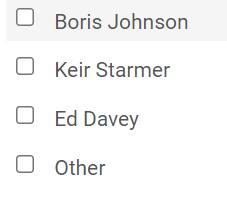Poll vs Survey: Difference and Uses

From the difference between surveys and questionnaires, to the variations that exist between surveys and online forms. When it comes to feedback and the different data collection methods available, there’s a lot to consider and understand if you’re to select the best one for your needs.
However, for the intents and purposes of this blog piece we’re going to be solely focusing on polls versus surveys.
The difference between a poll and a survey
Generally, when businesses refer to feedback, their needs typically fall into two camps. They’re either looking for more general or more detailed feedback.
Looking at the former, the general feedback of polls can be great for assessing the direction of a market. In contrast, the more detailed feedback provided by a survey, can help shape future strategy and action. This can be hugely valuable in areas such as customer satisfaction and employee relations.
It’s also important to note that because polls are only designed to provide a quick snapshot of people’s preferences on a particular issue, as opposed to the more detailed analysis and views offered by surveys, they tend to be much shorter than surveys.
However, to get a more detailed appreciation of the differences between these two approaches, it’s useful to explore each method in a bit more detail.
What are surveys good for?
Online surveys and the data they provide are valuable for many audiences and to many types of organisations in a multitude of industries.
So, whether it’s customer or employee feedback or data that can be used in market research. Organisations ranging from the government and public sector to those working in the private sector or specific industries ranging from education to healthcare, will be able to benefit, typically using the insight to shape their decision making and actions.
For example, if a company was looking to examine satisfaction among its customers concerning their recent experiences with them and their likelihood of returning, they might decide to run the following mix of survey questions to measure this.
How well would you rate your satisfaction of your most recent customer experience with us?

Based on your experience, how likely are you to make a repeat purchase with us?

What more could we do to improve your customer experience?

What are polls good for?
From market and political research to hospitality and event planning and feedback. The use of online polls can span a wide range of situations and purposes. But they are particularly beneficial when used in fast moving scenarios, where it’s crucial to keep both your audience interested and engaged, and keep on top of their fast-changing sentiment.
A good example, are political polls in the run up to a general election, where you could be asked a question similar to the following:
Who do you plan to vote for in the upcoming general election?

Running alongside this would be a live feed, where you could view the latest voting percentages for each candidate based on the current level of votes cast.
Knowing when to use a poll or a survey
Having taken you through the difference between a poll and a survey and what each are good for, you should have a better idea about when to use a poll or a survey.
However, as useful rule of thumb there are a few pointers to have in mind that can guide you on this.
| Poll | Survey |
| No detailed responses required | Often requires detailed and extensive feedback |
| Typically requires only one answer | Typically has many questions to answer |
| Feedback is usually immediate | Feedback is less immediate with more questions to answer |
| No personal information is required to participate | Usually requires some personal information to participate |
If you follow these, you’ll be better able to choose the best approach for your research and both maximise your response to and the insight gained from your questions.


